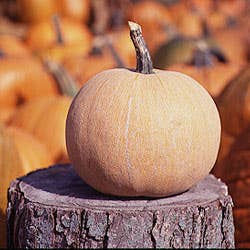
Prized Pumpkins
An in-depth look at what's growing in neighborhood pumpkin patches.
Connecticut Field Pumpkin
When most Americans think of pumpkins, they usually think of field pumpkins like these, which are grown in the northern U.S. Cooking isn't recommended because their meager flesh is stringy and bland. The shell is easy to cut, so use them for jack-o'-lanterns instead.
Cushaw
There are many regional varieties of cushaws (look for the characteristic "crook" in the neck), and some taste better than others. Green-striped cushaws, popular in the South, are mild in flavor. All are easy to cook; the neck is solid flesh. Use for pies or custards.
Hubbard Squash
Blue, green, and gold Hubbards grow almost everywhere but the South, and are great for pies and soups. The flesh is sweet (the green ones most of all) and the shell is very hard: Cut it open along a seam with a cleaver or ax—or drop the squash onto the sidewalk!
Wickersham Sweet Potato Pumpkin
This pumpkin grows in northern states. It has pale orange flesh and keeps well into winter. Despite the name (many squash are called "sweet potato"), its flesh is mild (it's good for savory dishes like ravioli). Most weigh 20-25 pounds, but they can grow to up to 50 pounds.
Winter Luxury Pie Pumpkin
The best pumpkin for pie. It has smooth orange flesh and pure pumpkin flavor, and weighs five to ten pounds, the perfect size for pie. Look for its netlike rind at stands and markets in the Northeast and Midwest. The sugar pie and other pie pumpkins are comparable.
Cheese Pumpkin
Many strains of cheese pumpkin are found in the U.S. All have a squat shape—like a wheel of cheese—and a distinct, fruity smell when cut open. The flesh appears stringy at first, but becomes creamy-smooth when cooked. Grill, roast, or use in ravioli or in baked goods.
Yellow Custard Marrow
These are mature pattypans, tiny summer squash that can be cooked like zucchini. Grown all over the U.S., they are great in stir-fries and hold their shape when steamed. If the outer shell is too hard to break with a fingernail, the squash is too mature to eat; use for decoration.
Rouge Vif d'Etampes
This French variety, also called the Cinderella pumpkin, looks like a bright orange cheese pumpkin, but it is actually a different species. The flesh is very thick and pumpkins are usually heavier than they look. They are traditionally used for soups but are also great for pies.
Keep Reading
Continue to Next Story


















